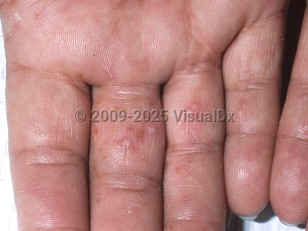Dyshidrotic dermatitis in Child
Alerts and Notices
Important News & Links
Synopsis

Dyshidrotic dermatitis is rare in younger children. When arising in the pediatric population, it is generally seen after the age of 10. The condition often presents episodically, more commonly in warm weather.
Dyshidrotic eczema has been associated with atopic dermatitis, contact irritants and allergens, dermatophyte and bacterial infections, hyperhidrosis, hot weather, diet, and emotional stress. Administration of intravenous immunoglobulin (IVIG) has been associated with severe dyshidrotic dermatitis. There have also been a few reports of dyshidrotic dermatitis in adults treated with secukinumab.
Some cases spontaneously resolve. Treatment is aimed at symptomatic relief and control of vesiculation.
Codes
L30.1 – Dyshidrosis [pompholyx]
SNOMEDCT:
201201000 – Podopompholyx
402222007 – Vesicular hand eczema
Look For
Subscription Required
Diagnostic Pearls
Subscription Required
Differential Diagnosis & Pitfalls

Subscription Required
Best Tests
Subscription Required
Management Pearls
Subscription Required
Therapy
Subscription Required
Drug Reaction Data
Subscription Required
References
Subscription Required
Last Updated:12/16/2020
 Patient Information for Dyshidrotic dermatitis in Child
Patient Information for Dyshidrotic dermatitis in Child- Improve treatment compliance
- Reduce after-hours questions
- Increase patient engagement and satisfaction
- Written in clear, easy-to-understand language. No confusing jargon.
- Available in English and Spanish
- Print out or email directly to your patient


